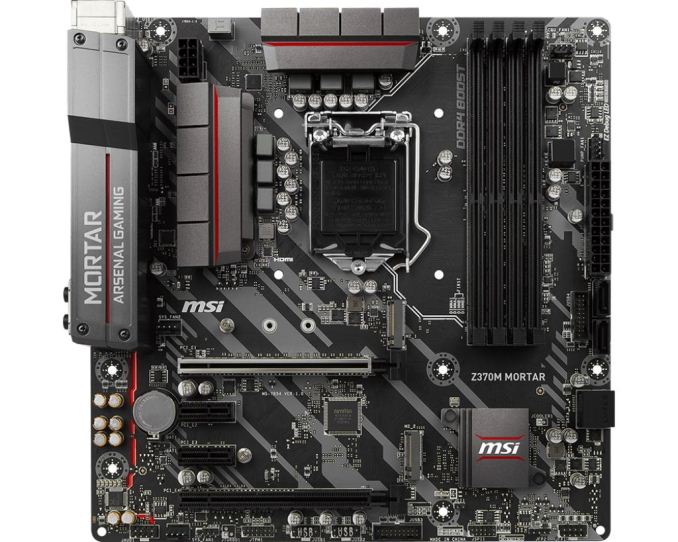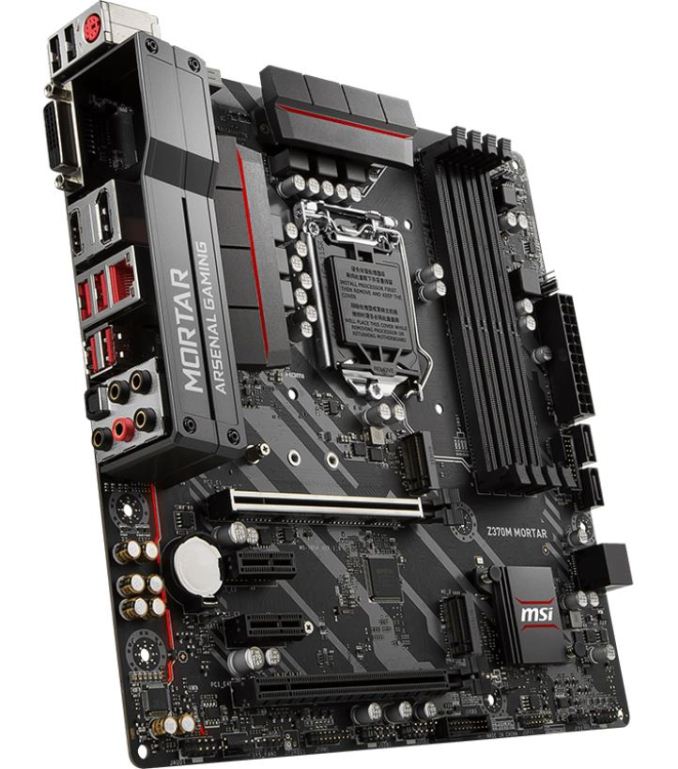Analyzing Z370 for Intel's 8th Generation Coffee Lake: A Quick Look at 50+ Motherboards
by Ian Cutress, Anton Shilov, Joe Shields & Gavin Bonshor on October 20, 2017 2:00 PM ESTMSI Z370M Mortar
The Mortar’s appearance does have a more rugged look compared to the other MSI micro-ATX board, the Z370M Gaming Pro AC. The Mortar’s back panel cover looks like it was taken from a military vehicle with the aesthetic only screws on both ends giving it an industrial feel. The heatsinks are simple grey with a red line through the middle, in contrast to the jet black PCB that has some grey design features on the board. There are no onboard RGB LEDs, with the only support provided through an onboard header. A single full-length PCIe slot is reinforced, with the focus for this board on single GPU setups. The PCH heatsink is a diminutive piece with the MSI name on it in white letters with red accents and is attached via pushpins.
MSI still uses all four memory slots here, capable of up to 64 GB and on-the-box speeds of DDR4-4000. Despite the industrial feel to the board, there is no memory slot reinforcement here, and MSI has used dual-sided latch mechanisms over the single-sided latch versions we sometimes see on high-end motherboards. For PCIe, the top reinforced slot handles the main add-in card duty, supporting PCIe 3.0 x16 direct from the processor. The other full-length slot is a PCIe x4 slot from the chipset, and the board also has two smaller PCIe x1 slots in between.
As with the other MSI micro-ATX board, there is only four SATA ports here, with two in a 'regular' position and the other two sitting vertically on the board just below the 24-pin ATX connector. These last two are also right next to a USB 3.0 internal header, and in a position that might make it difficult to release locking SATA cables if a front panel cable is attached to the USB 3.0 header. Other storage comes via dual M.2 slots, with the Mortar supporting 80mm drives in both, however, the first slot is PCIe only, with the second slot able to do both PCIe and SATA.
The Mortar will accept a total of four fans with its 4-pin headers, two of which are located around the chipset. The 4-pin headers support both PWM and voltage control. Network connectivity is through a sole Intel I219-V gigabit Ethernet controller, with the price of this board meaning that Wi-Fi is not present. The audio codec is also lower than 'normal' to save a few pennies, however the Realtek ALC892 codec still offers 7.1 channel support. MSI has at least offered some PCB separation to reduce electrical interference with the audio paths.
USB Support for the Mortar is missing the latest USB 3.1 (10 Gbps), but it has a total of eight USB 3.1 (5 Gbps) ports: there are four Type-A on the back panel, and four more available through the two internal headers. The board also has two USB 2.0 ports on the back panel and two internal headers. The rest of the Mortar’s panel consists of a combination PS/2 port, DVI-D/HDMI/DisplayPort video outputs, the network connection, and the audio jacks with SPDIF.
| MSI Z370M Mortar | |
| Warranty Period | 3 Years |
| Product Page | Link |
| Price | N/A |
| Size | Micro-ATX |
| CPU Interface | LGA1151 |
| Chipset | Intel Z370 Express |
| Memory Slots (DDR4) | Four DDR4 Supporting 64GB Dual Channel Support DDR4 4000+ |
| Network Connectivity | 1 x Intel I219-V |
| Onboard Audio | Realtek ALC892 |
| PCIe from CPU | 1 x PCIe 3.0 x16 slots |
| PCIe from Chipset | 1 x PCIe 3.0 x4 2 x PCIe 3.0 x1 slots |
| Onboard SATA | 4 x Supporting RAID 0/1/5/10 |
| Onboard SATA Express | None |
| Onboard M.2 | 2 x PCIe 3.0 x4 Slot 1 PCIe only Slot 2 PCIe or SATA |
| Onboard U.2 | None |
| USB 3.1 (10 Gbps) | N/A |
| USB 3.1 (5 Gbps) | 4 x Back Panel 2 x Headers |
| USB 2.0 | 2 x Back Panel 2 x Headers |
| Power Connectors | 1 x 24-pin EATX 1 x 8-pin ATX 12V |
| Fan Headers | 1 x 4-pin CPU 1 x 4-pin Waterpump 2 x 4-pin System Fan (All PWM or Voltage controlled) |
| IO Panel | 1 x Combination PS/2 2 x USB 2.0 1 x DisplayPort 1 x DVI-D port 1 x HDMI port 1 x LAN (RJ45) port 4 x USB 3.1 (5 Gbps) Type-A ports 5 x Audio Jacks + SPDIF |












83 Comments
View All Comments
weevilone - Wednesday, October 25, 2017 - link
Notable that though the new boards are often very similar to their Z270 predecessors, Asus has dropped Thunderbolt 3 support from the Maximus X Hero board.masouth - Thursday, October 26, 2017 - link
ASUS ROG Z370 Maximus X Hero"....new metallic heat sinks that are an upgrade over the plastic heatsinks found on the Z270 version"
Please excuse my ignorance because I didn't own a ROG Z270 mb but...plastic HEAT SINKS? Not shrouds or decoration over a heat sink but the actual heat sinks themselves? That's either wrong, they performed their job pretty poorly, or plastic resins have advanced a lot farther in thermal conductivity (and cost for such) than I realized.
flowrush - Sunday, November 19, 2017 - link
"The other main distinguishable feature is the inclusion of integrated 802.11ac Wi-Fi with an antenna (that can only be described as a shark fin) found on the F."The above is incorrect in the article. The integrated Wi-Fi module with antenna is found on the E not the F.
Coldgame - Saturday, November 25, 2017 - link
I'm looking to build a rig with the Z370 Gaming ITX/ac, a GTX-1070 card and an Apple Thunderbolt Display.The review states:
"The key difference in the support between the two boards is going to be the Thunderbolt 3 port on the Gaming-ITX. This port supports video outputs..."
So, can anyone confirm or deny that video generated by the GTX-1070 can be output through the onboard Thunderbolt 3 port?
hanselltc - Sunday, December 3, 2017 - link
Looking forward to low-middle end mITX choices from this platform. It'll probably be paired with a 8100/8300 and be my secondary machine.Roen - Sunday, February 4, 2018 - link
Where are the 10 Gbps ports on the back? They all look like 5 Gbps ports, even the Type C.rbarak - Wednesday, February 21, 2018 - link
Is anyone using the Z370-P on Linux with two screens?I built a new machine based on the Z370-P, and both the DVI and the HDMI connected screens show the same image, and the RHEL7 setup/displays show only one Unknown Display.
I follwed the advice on stackexchange, and added this line:
$ grep GRUB_CMDLINE_LINE_DEFAULT /etc/default/grub
GRUB_CMDLINE_LINE_DEFAULT="i915.alpha_support=1"
Then I did:
sudo grub2-mkconfig -o "$(readlink /etc/grub2.conf)"
And rebooted, but still, the two displays are not shown.
dromoxen - Wednesday, May 9, 2018 - link
Shocked to see that both the Asrock mitx boards are "szie=ATX" .. LOLThe addition of Tunderbolt sure seems to add a hefty premium £120 vs £160 , luckily I can do without.
Kroebo - Sunday, October 7, 2018 - link
Sadly, I discovered that the ZUG Gaming PLUS doesn't support SLI.trag - Tuesday, January 15, 2019 - link
On the ASrock Z370M Pro4 the M.2 slot information is backwards. Both slots support NVME. One slot also supports SATA. As written, "The first M.2 slot is SATA only while the second supports PCIe." it seems to say that one slot is SATA only and the other slot is PCIe (NVME) only.